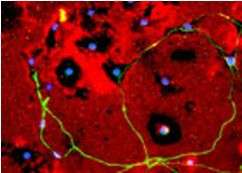New clues to why nerve cells fail to grow in scar tissue

(PhysOrg.com) -- A new study led by researchers at the Wellcome Trust Centre for Human Genetics, University of Oxford, has shown how the battle between two competing molecules can determine whether nerve cells grow and migrate or whether, in the case of scar tissue, they are inhibited, severely limiting recovery from damage to the central nervous system.
The regeneration of nerve cells within and across scar tissue is inhibited by a molecule known as chondroitin sulphate proteoglycan (CSPG), which is produced in large amounts in scar tissue after damage to the nervous system. Previous work has shown that this molecule interacts with a protein found on the surface of the nerve cells, essentially switching cell movement 'off' (1).
In a new study, published online in the journal 'Science', researchers have shown that a closely related family of molecules, the heparan sulphate proteoglycans (HSPGs), typically promote nerve growth by acting on this same protein switch to turn 'on' cell growth (2). In fact, both types of molecule act on the same component of the switch, known as a receptor, as revealed by high-resolution structural work performed at the UK synchrotron facility, the Diamond Light Source.
"These two molecules target exactly the same site on this protein switch, which poses the question: how can they produce opposing effects on the growth of nerve cells?" says Dr Radu Aricescu.
The new research suggests that HSPGs are able to bind together multiple copies of the receptor, creating clusters of the protein on the surface of the nerve cell. This allows signalling to other proteins inside the cells responsible for cell movement. Without this signal, the nerve cells are unable to move into the damaged tissue.
"Earlier work suggested that drugs blocking the interaction of CSPG with the protein switch would be beneficial to nerve regeneration," says Dr Charlotte Coles, first author of the study and a Wellcome Trust PhD student at the time of the research. "Our work has added an unexpected twist to the story, however: such molecules would also block the positive effect of HSPGs, so the benefits would be minimal, if any."
The researchers believe that drugs that promote the clustering activity - thus mimicking the action of HSPGs rather than simply blocking CSPG interactions - are likely to prove beneficial in aiding nerve regeneration after nervous system injury.
The research was carried out in collaboration with scientists at the University of Manchester, Harvard Medical School and Columbia University.
More information:
(1) Shen et al. PTPsigma is a receptor for chondroitin sulfate proteoglycan, an inhibitor of neural regeneration. Science 2009;326:592-596
(2) Coles CH et al. Proteoglycan-specific molecular switch for RPTPσ clustering and neuronal extension. Science Express 2011 [epub ahead of print]

















